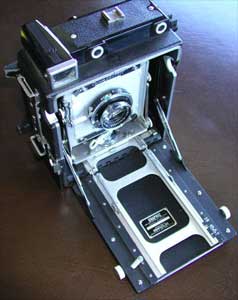Well, I screwed out my courage and plonked down the huge sum of $300 for a 50 year old 4×5 camera, a Graflex Crown Graphic. It’s a logical migration in a life which started with 35mm, then saw 6×6 come on the scene some 15 years ago. The latter proved ideal when 16x prints were expected rather than hoped for. Yes, you can get there with a Leica but everything has to be just about dead right for a perfect print that large. On occasion I can make a Big Print where you cannot tell whether 35mm or 6×6 was used, but not always. So when detail in the details matters the Mamiya 6 or Rollei 6003 comes out – the latter somewhat reluctantly, it should be added, owing to its great weight. Anyway, the Mamiya’s lenses are better, if less varied.
I started thinking about Going Big over the past couple of years. Not wanting to spend a fortune on what is probably a dying medium, I nonetheless desired something a little better than a home made pinhole camera for my tentative entry to the world of black headcloths (OK, my old green Scottish wool pullover which is always with me, in my case) and de rigeur tripods. Further, a growing interest in abstract nature photography, spurred by Eliot Porter’s great work, meant that definition in the final image would have to be good. Really good.
I was so completely clueless about the world of large format photography, when I started research I had no idea what a film holder was, and little more than a basic appreciation of the physics of camera movements, tilts, shift and so on. The World Wide Web soon fixed that, especially the splendid site at Large Format photography where many selfless contributors offer a fine education in the basics.
So where to get this contradiction in terms, a top quality, cheap large format camera? Simple. I did what many before me have done when dipping a toe in the waters, and purchased a Graflex Crown Graphic, beloved by many press photographers in the 1940s and 1950s. My $300 got me a pristine camera, a 135mm Schneider Xenar ‘standard’ lens (like a 40mm on 35mm film) and a couple of wooden film holders, each holding two sheets of film. So now I can go on the road and take 4 pictures before ‘reloading’ in a changing bag. Not a big deal. I take few pictures in any case and filmholders can be had for $5-10 each if I need more.
The quality of the camera is a superb meeting of form and function. First, it is unbelievably light, owing to the extensive use of aluminum where it matters. The body is wood covered with leatherette. It is also amazingly compact when folded up. Believe it or not it has a coupled rangefinder with a separate, parallax corrected, viewfinder. And did I mention the night focusing device? So you thought infrared focusing aids started with digital cameras? How about an internal, battery illuminated bulb which, when switched on, projects a light beam on the subject through the rangefinder, alignment of the two beams denoting sharp focus? And, the whole thing being industrial grade, needless to say the bulb in my Crown Graphic worked first time, needing only fresh batteries. It had never been used. The manufacturer’s dummy batteries, in the form of two wooden dowels, resided in the camera on receipt!
It was a matter of two minutes to remove the rangefinder housing, adjust the rangefinder for accuracy and proper image coincidence, and a drop of blue Loctite later I had a focusing aid every bit as good as those to be found on pre-M Leicas. A gentle cleaning of the glasses and mirrors and everything is now crystal clear.
So now I have three Leicas – my M2 German original, my Texas Leica (Mamiya 6) and my Godzilla Leica. Having splashed out a further $5 on a cable release, I’m now wondering where I hid my tripod. I’m trying the whole thing out today at my Top Secret location off gorgeous Highway One. And no, I’m not telling where that is.
